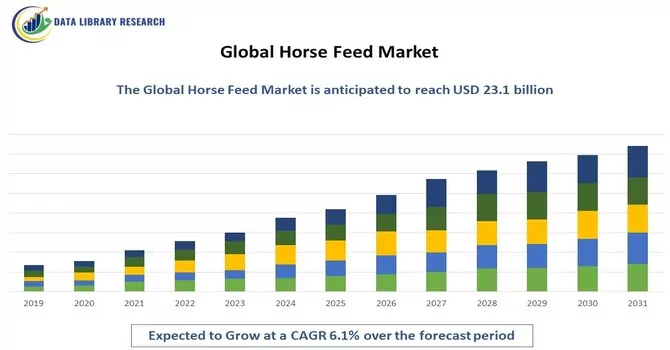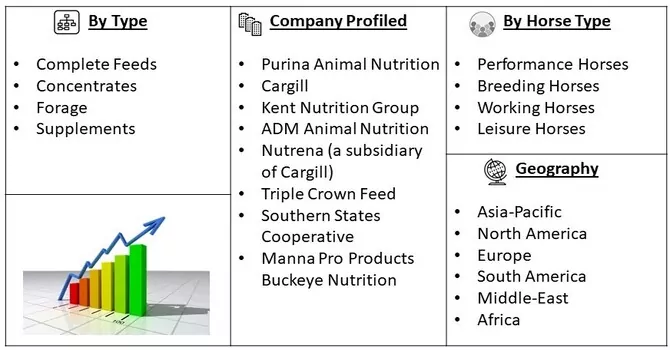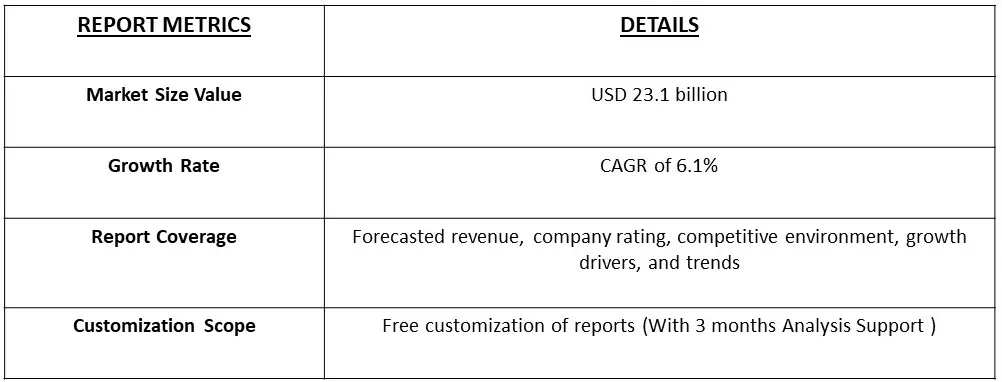The global horse feed market is expected to continue its growth trajectory, with the market value projected to reach 14.3 billion in 2023 and 23.1 billion by 2031, representing a compound annual growth rate (CAGR) of 6.1% from 2023 to 2031.

Get Complete Analysis Of The Report - Download Free Sample PDF
The horse feed market comprises the sector involved in producing and distributing nutritional products specifically formulated for horses. This market includes various feed types, such as concentrates, forage, supplements, and complete feeds, designed to meet the dietary needs of horses for health, performance, and growth. Key factors influencing the market include advancements in feed formulations, increasing awareness of horse nutrition, and rising demand from the equestrian sports industry. The market is shaped by regulatory standards, innovation in feed ingredients, and the growing emphasis on enhancing horse health and performance.
This growth is driven by increasing demand for high-quality horse feed, rising awareness of horse health and nutrition, and the growing popularity of horse riding and equestrian sports. Additionally, the market is expected to benefit from advancements in feed technology, increasing availability of organic and natural horse feed options, and expansion of the equine industry in emerging markets.
The global horse feed market is seeing several key trends, including a growing shift towards premium and specialized feed formulations that cater to specific needs such as performance enhancement, digestive health, and age-specific nutrition. Horse owners are increasingly seeking out feeds that incorporate natural and organic ingredients, driven by a broader trend towards holistic and sustainable animal care.
The market is also witnessing the rise of functional feeds, which include additives like probiotics, prebiotics, and omega-3 fatty acids to support overall health and immunity. Additionally, customized feeding programs tailored to individual horses' needs are becoming more popular, supported by advances in equine nutrition research and technology. These trends reflect a broader emphasis on optimizing equine health and performance through precise, high-quality nutrition, driving innovation and growth in the horse feed market.
Market Segmentation: The Global Horse Feed Market is segmented by Type of Feed (Complete Feeds, Concentrates, Forage and Supplements), Horse Type (Performance Horses, Breeding Horses, Working Horses and Leisure Horses) and geography (Asia-Pacific, North America, Europe, South America, and Middle East and Africa). The report offers the market size and forecasts for revenue (USD million) for all the above segments.

For Detailed Market Segmentation - Download Free Sample PDF
Market Drivers:
Increasing Participation in Equestrian Sports and Leisure Activities:
The growing popularity of equestrian sports such as dressage, show jumping, and racing is a major driver of the global horse feed market. As more individuals participate in these activities, either professionally or recreationally, the demand for specialized horse feed that supports high performance, endurance, and recovery has surged. Horses involved in competitive sports require diets rich in energy, protein, vitamins, and minerals to maintain optimal health and achieve peak performance. Consequently, owners and trainers are investing in premium, performance-enhancing feed formulations tailored to meet the specific nutritional needs of their horses. This trend is particularly strong in regions like North America and Europe, where equestrian sports have a long-standing tradition and are supported by well-established industries, contributing to the steady growth of the horse feed market.
Rising Awareness of Equine Health and Nutrition:
There is a growing awareness among horse owners and caregivers about the importance of proper nutrition in maintaining the overall health and well-being of horses. This awareness is driving the demand for high-quality, nutritionally balanced feeds that cater to the specific needs of different horse breeds, life stages, and health conditions. For instance, older horses may require feeds that are easier to digest and contain joint-supporting ingredients, while young, growing horses need diets rich in calcium and phosphorus for proper bone development. Additionally, the increasing prevalence of equine diseases such as colic and laminitis has led to a greater focus on preventive nutrition, encouraging the use of feeds that promote gut health and reduce the risk of digestive disorders. The trend towards natural and organic feed ingredients, free from artificial additives and preservatives, also reflects the growing consumer demand for products that align with the principles of holistic animal care. This rising awareness and emphasis on tailored nutrition are key drivers propelling the global horse feed market forward.
Market Restraints:
The global horse feed market faces several restraints that could hinder its growth. One of the primary challenges is the fluctuating cost of raw materials, such as grains, oats, and other essential feed ingredients, which can lead to inconsistent pricing and supply chain disruptions. These fluctuations are often driven by climate change, agricultural yield variability, and global trade dynamics, making it difficult for manufacturers to maintain stable pricing and profitability. Additionally, the market is constrained by the lack of awareness and education among horse owners, particularly in emerging markets, regarding the nutritional needs of horses and the benefits of specialized feeds. This can lead to underutilization of premium and specialized feed products, limiting market growth. Furthermore, the strict regulatory environment governing animal feed production, especially in regions like North America and Europe, imposes significant compliance costs and challenges, particularly for smaller manufacturers. These regulations, while necessary to ensure quality and safety, can increase production costs and create barriers to entry. Lastly, the high cost of premium horse feeds can deter some owners, particularly in price-sensitive markets, where budget constraints may lead to the preference for more basic or locally sourced feeds over specialized formulations. These factors collectively pose challenges to the sustained growth of the global horse feed market.
The COVID-19 pandemic had a mixed impact on the global horse feed market. Initially, the market faced significant disruptions due to supply chain interruptions, labor shortages, and restrictions on transportation, which affected the availability and cost of raw materials needed for horse feed production. These challenges were particularly acute in regions with heavy reliance on imported feed ingredients. Additionally, the economic downturn caused by the pandemic led to reduced spending power among horse owners, particularly in the leisure and sports sectors, resulting in a decline in demand for premium and specialized horse feeds. However, as the pandemic progressed, there was a noticeable shift in consumer behavior, with many horse owners focusing more on the health and well-being of their animals, leading to sustained demand for quality feeds. The rise in backyard farming and home-based equestrian activities also helped stabilize the market. Furthermore, the industry's resilience was bolstered by the increasing use of e-commerce platforms for purchasing horse feed, which helped mitigate the impact of physical retail disruptions. Overall, while the pandemic posed significant challenges, it also highlighted the importance of adaptive strategies and innovation in the horse feed market.
Segmental Analysis:
Complete Feeds Segment is Expected to Witness Significant Growth Over the Forecast Period
Complete Feeds: The complete feeds sub-segment in the horse feed market is increasingly popular due to its convenience and nutritional balance. These feeds are designed to provide horses with all the essential nutrients they need in a single product, simplifying feeding practices for horse owners. Recent developments include formulations that address specific health needs, such as joint support and digestive health, reflecting the growing focus on holistic horse care. The driving factors for this sub-segment include the demand for time-efficient feeding solutions, the rise in equestrian sports, and advancements in nutritional science that enhance feed effectiveness. Additionally, the increasing awareness of horse health and wellness contributes to the preference for complete feeds that ensure balanced nutrition.
Performed Horses Segment is Expected to Witness Significant Growth Over the Forecast Period
Performance Horses: The performance horses sub-segment caters to horses involved in competitive activities such as racing, dressage, and show jumping. This feed is specially formulated to meet the high energy and nutritional demands of these horses. Recent advancements include the development of high-performance feeds with added supplements for muscle recovery and stamina enhancement. The driving factors for this sub-segment include the growing popularity of equestrian sports, the need for optimized performance and recovery, and the increasing investment in high-quality horse care. As competition levels rise, the demand for specialized feeds that support peak performance and health continues to grow.
North America Region is Expected to Witness Significant Growth Over the Forecast Period
The North American horse feed market is experiencing robust growth driven by several key factors. The region benefits from a well-established equestrian culture and a high number of horse owners involved in both recreational and competitive riding. Increased awareness of horse nutrition and advancements in feed technology contribute to the growing demand for specialized and high-quality feed products. Additionally, the region's strong distribution networks and widespread availability of diverse feed options support market expansion. Rising disposable incomes and a focus on premium horse care products further boost the market. Government regulations promoting animal health and safety also play a role in driving the growth of the North American horse feed market.
The competitive landscape of the North American horse feed market is highly dynamic, featuring a mix of established industry leaders and innovative new entrants. These companies compete based on product quality, nutritional formulations, and brand reputation, leveraging advanced manufacturing technologies and comprehensive distribution networks. The market is characterized by continuous innovation in feed formulations and a focus on meeting diverse customer needs, from performance enhancement to specialized health benefits. The competitive dynamics are further shaped by trends in consumer preferences, regulatory standards, and ongoing investments in research and development.
Key players include:

Get Complete Analysis Of The Report - Download Free Sample PDF
Recent Development:
1) Purina Animal Nutrition launched a new line of advanced performance feeds in early 2024, specifically designed for high-level competitive horses. This product line incorporates cutting-edge nutritional science to enhance muscle recovery, endurance, and overall health. The introduction of these feeds reflects Purina's commitment to supporting elite equestrian athletes with tailored solutions that meet their rigorous demands. This development underscores the company's strategic focus on innovation and addressing the evolving needs of the performance horse sector, reinforcing its position as a leader in the North American horse feed market.
2) Cargill announced the acquisition of Blue Seal Feeds in late 2023, significantly expanding its footprint in the North American horse feed market. This strategic move allows Cargill to leverage Blue Seal's established product portfolio and distribution network, enhancing its market presence and product offerings. The acquisition aligns with Cargill’s growth strategy to enhance its product range and reach a broader customer base, strengthening its competitive edge in the industry. This development reflects Cargill’s commitment to expanding its capabilities and meeting the growing demand for high-quality horse feed solutions.
Q1. What are the driving factors for the Global Horse Feed market?
The global horse feed market is driven by several key factors, including the increasing global equestrian population and growing participation in competitive riding sports. Rising awareness of proper horse nutrition and the need for specialized feed formulations tailored to different horse types and performance levels also contribute to market growth. Additionally, advancements in feed technology and the development of high-quality, nutritionally balanced feeds enhance horse health and performance. The expansion of premium and specialized feed products and the rising disposable income of horse owners further support market expansion.
Q2. What are the restraining factors for the Global Horse Feed market?
The global horse feed market faces several restraining factors, including the high cost of premium and specialized feed products, which can limit accessibility for some horse owners. Fluctuations in raw material prices and supply chain disruptions can also impact feed production costs. Additionally, regulatory challenges and compliance with various international standards can create barriers to market entry and expansion. Seasonal variations in feed demand and competition from alternative feed options may also restrain market growth.
Q3. Which segment is projected to hold the largest share in the Global Horse Feed market?
The complete feeds segment is projected to hold the largest share in the global horse feed market. Complete feeds provide a balanced diet that meets all the nutritional needs of horses, offering convenience and ensuring optimal health and performance. The demand for complete feeds is driven by their ability to simplify feeding practices and provide comprehensive nutrition, which appeals to both recreational and competitive horse owners.
Q4. Which region holds the largest share in the Global Horse Feed market?
North America holds the largest share in the global horse feed market. The region benefits from a strong equestrian culture, high levels of horse ownership, and a well-established infrastructure for feed production and distribution. The prevalence of competitive riding and recreational horse activities, along with significant investment in horse care and nutrition, further contributes to North America's dominant position in the market.
Q5. Which are the prominent players in the Global Horse Feed market?
Prominent players in the global horse feed market include Purina Animal Nutrition, Cargill, Kent Nutrition Group, ADM Animal Nutrition, Nutrena (a subsidiary of Cargill), Triple Crown Feed, Southern States Cooperative, Manna Pro Products, and Buckeye Nutrition. These companies are key contributors to the market due to their extensive product portfolios, innovation in feed formulations, and strong distribution networks. Their strategic initiatives and investments in research and development drive their significant presence and competitive positioning in the industry.
Data Library Research are conducted by industry experts who offer insight on industry structure, market segmentations technology assessment and competitive landscape (CL), and penetration, as well as on emerging trends. Their analysis is based on primary interviews (~ 80%) and secondary research (~ 20%) as well as years of professional expertise in their respective industries. Adding to this, by analysing historical trends and current market positions, our analysts predict where the market will be headed for the next five years. Furthermore, the varying trends of segment & categories geographically presented are also studied and the estimated based on the primary & secondary research.
In this particular report from the supply side Data Library Research has conducted primary surveys (interviews) with the key level executives (VP, CEO’s, Marketing Director, Business Development Manager and SOFT) of the companies that active & prominent as well as the midsized organization
FIGURE 1: DLR RESEARH PROCESS

Extensive primary research was conducted to gain a deeper insight of the market and industry performance. The analysis is based on both primary and secondary research as well as years of professional expertise in the respective industries.
In addition to analysing current and historical trends, our analysts predict where the market is headed over the next five years.
It varies by segment for these categories geographically presented in the list of market tables. Speaking about this particular report we have conducted primary surveys (interviews) with the key level executives (VP, CEO’s, Marketing Director, Business Development Manager and many more) of the major players active in the market.
Secondary ResearchSecondary research was mainly used to collect and identify information useful for the extensive, technical, market-oriented, and Friend’s study of the Global Extra Neutral Alcohol. It was also used to obtain key information about major players, market classification and segmentation according to the industry trends, geographical markets, and developments related to the market and technology perspectives. For this study, analysts have gathered information from various credible sources, such as annual reports, sec filings, journals, white papers, SOFT presentations, and company web sites.
Market Size EstimationBoth, top-down and bottom-up approaches were used to estimate and validate the size of the Global market and to estimate the size of various other dependent submarkets in the overall Extra Neutral Alcohol. The key players in the market were identified through secondary research and their market contributions in the respective geographies were determined through primary and secondary research.
Forecast Model
